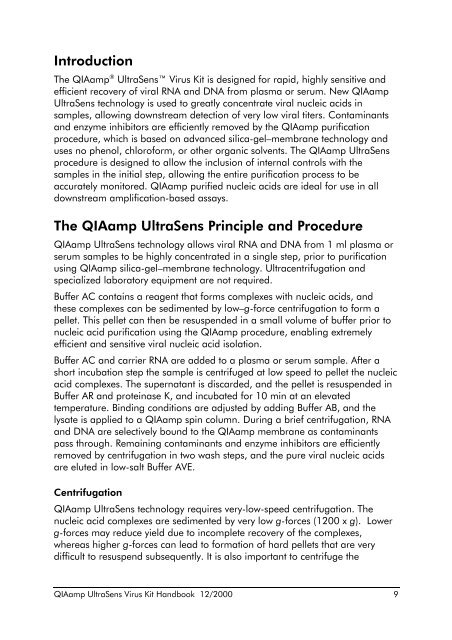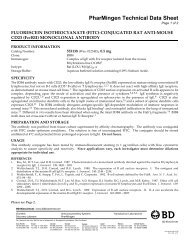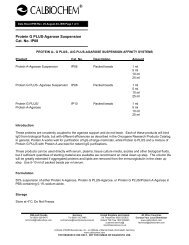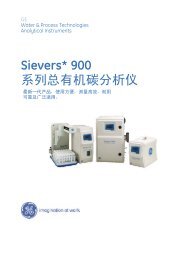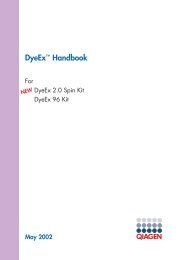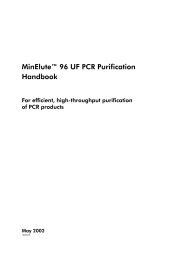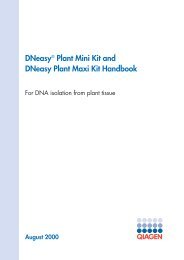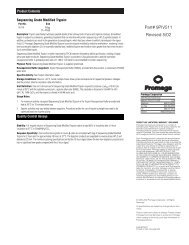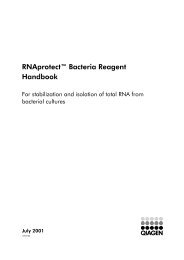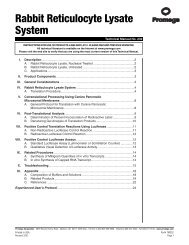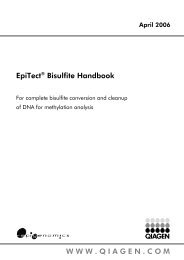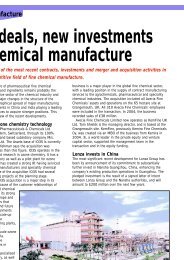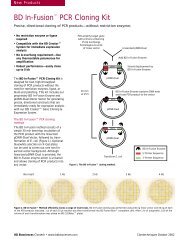QIAamp UltraSens Virus Kit Handbook 12/00 (PDF
QIAamp UltraSens Virus Kit Handbook 12/00 (PDF
QIAamp UltraSens Virus Kit Handbook 12/00 (PDF
You also want an ePaper? Increase the reach of your titles
YUMPU automatically turns print PDFs into web optimized ePapers that Google loves.
Introduction<br />
The <strong>QIAamp</strong> ® <strong>UltraSens</strong> <strong>Virus</strong> <strong>Kit</strong> is designed for rapid, highly sensitive and<br />
efficient recovery of viral RNA and DNA from plasma or serum. New <strong>QIAamp</strong><br />
<strong>UltraSens</strong> technology is used to greatly concentrate viral nucleic acids in<br />
samples, allowing downstream detection of very low viral titers. Contaminants<br />
and enzyme inhibitors are efficiently removed by the <strong>QIAamp</strong> purification<br />
procedure, which is based on advanced silica-gel–membrane technology and<br />
uses no phenol, chloroform, or other organic solvents. The <strong>QIAamp</strong> <strong>UltraSens</strong><br />
procedure is designed to allow the inclusion of internal controls with the<br />
samples in the initial step, allowing the entire purification process to be<br />
accurately monitored. <strong>QIAamp</strong> purified nucleic acids are ideal for use in all<br />
downstream amplification-based assays.<br />
The <strong>QIAamp</strong> <strong>UltraSens</strong> Principle and Procedure<br />
<strong>QIAamp</strong> <strong>UltraSens</strong> technology allows viral RNA and DNA from 1 ml plasma or<br />
serum samples to be highly concentrated in a single step, prior to purification<br />
using <strong>QIAamp</strong> silica-gel–membrane technology. Ultracentrifugation and<br />
specialized laboratory equipment are not required.<br />
Buffer AC contains a reagent that forms complexes with nucleic acids, and<br />
these complexes can be sedimented by low–g-force centrifugation to form a<br />
pellet. This pellet can then be resuspended in a small volume of buffer prior to<br />
nucleic acid purification using the <strong>QIAamp</strong> procedure, enabling extremely<br />
efficient and sensitive viral nucleic acid isolation.<br />
Buffer AC and carrier RNA are added to a plasma or serum sample. After a<br />
short incubation step the sample is centrifuged at low speed to pellet the nucleic<br />
acid complexes. The supernatant is discarded, and the pellet is resuspended in<br />
Buffer AR and proteinase K, and incubated for 10 min at an elevated<br />
temperature. Binding conditions are adjusted by adding Buffer AB, and the<br />
lysate is applied to a <strong>QIAamp</strong> spin column. During a brief centrifugation, RNA<br />
and DNA are selectively bound to the <strong>QIAamp</strong> membrane as contaminants<br />
pass through. Remaining contaminants and enzyme inhibitors are efficiently<br />
removed by centrifugation in two wash steps, and the pure viral nucleic acids<br />
are eluted in low-salt Buffer AVE.<br />
Centrifugation<br />
<strong>QIAamp</strong> <strong>UltraSens</strong> technology requires very-low-speed centrifugation. The<br />
nucleic acid complexes are sedimented by very low g-forces (<strong>12</strong><strong>00</strong> x g). Lower<br />
g-forces may reduce yield due to incomplete recovery of the complexes,<br />
whereas higher g-forces can lead to formation of hard pellets that are very<br />
difficult to resuspend subsequently. It is also important to centrifuge the<br />
<strong>QIAamp</strong> <strong>UltraSens</strong> <strong>Virus</strong> <strong>Kit</strong> <strong>Handbook</strong> <strong>12</strong>/2<strong>00</strong>0 9


